Carbon Sequestration in the Aboveground Living Biomass of Windbreaks—Climate Change Mitigation by Means of Agroforestry in Hungary
Abstract
1. Introduction
2. Materials and Methods
2.1. Data Sources and Sampling
2.2. Methods of the Analysis
2.3. Characteristics of the Hanság and the Hajdúhát-Bihar Forest Planning Districts
3. Results
4. Discussion
5. Conclusions
Author Contributions
Funding
Data Availability Statement
Conflicts of Interest
Appendix A
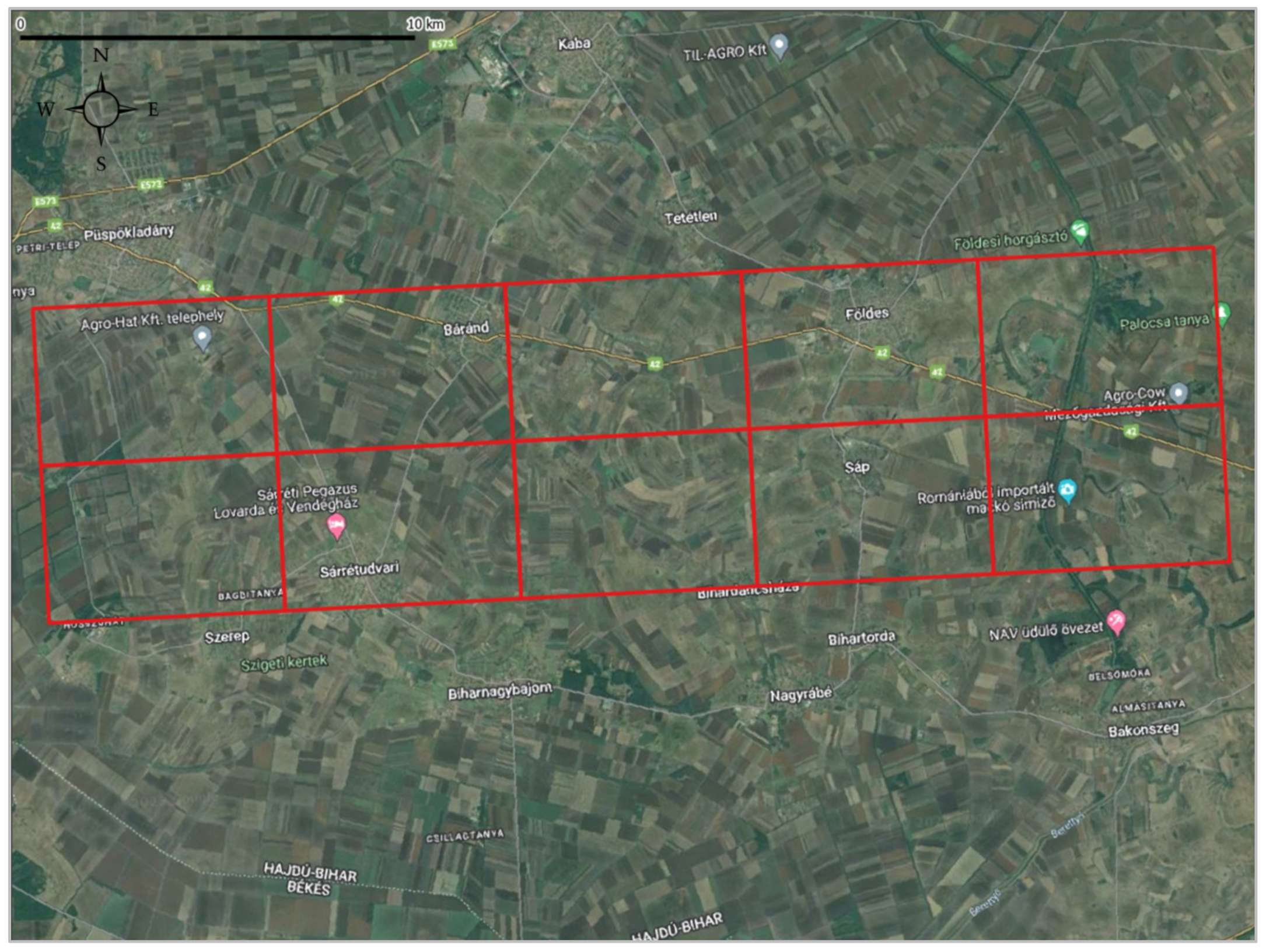
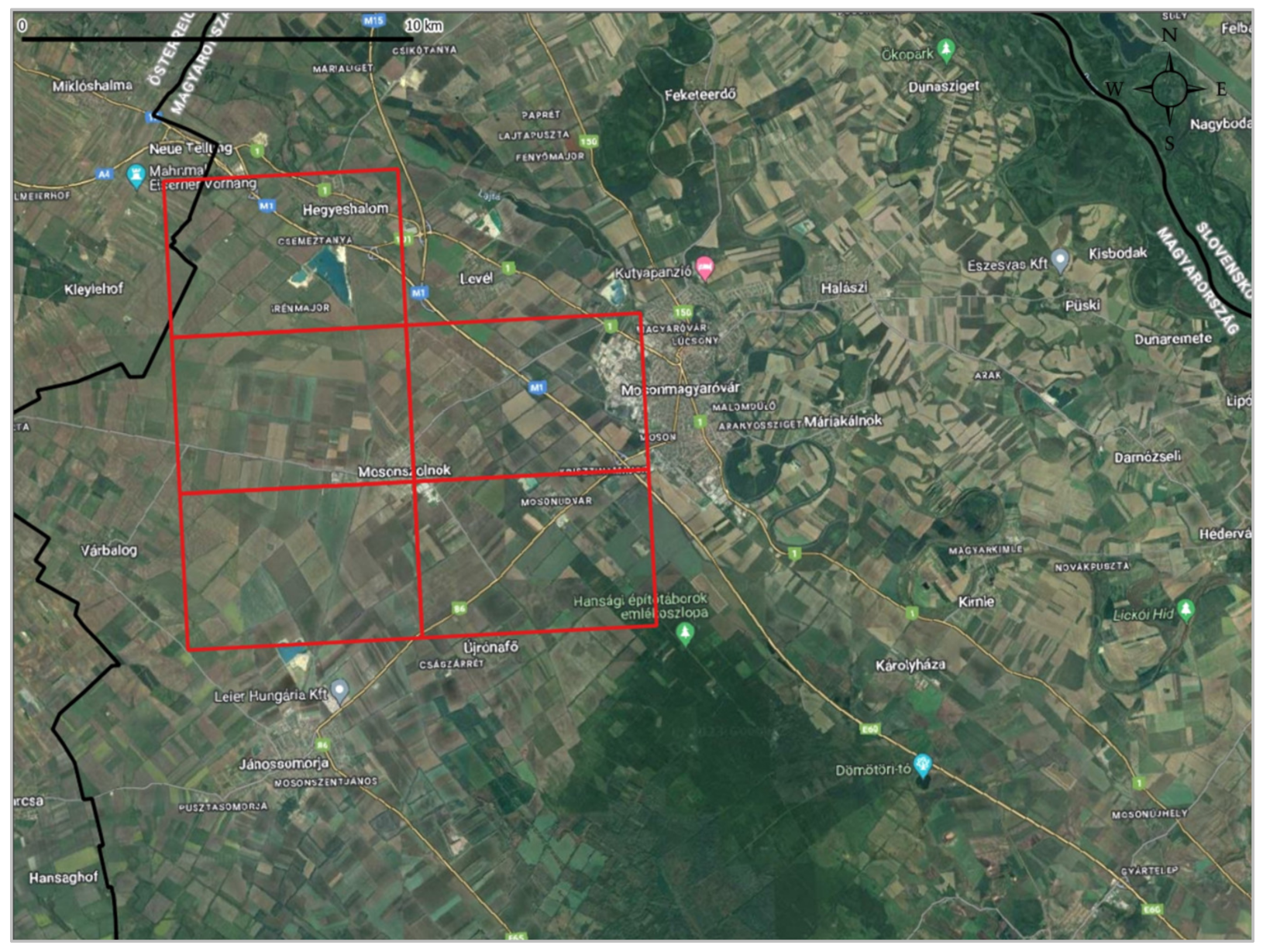
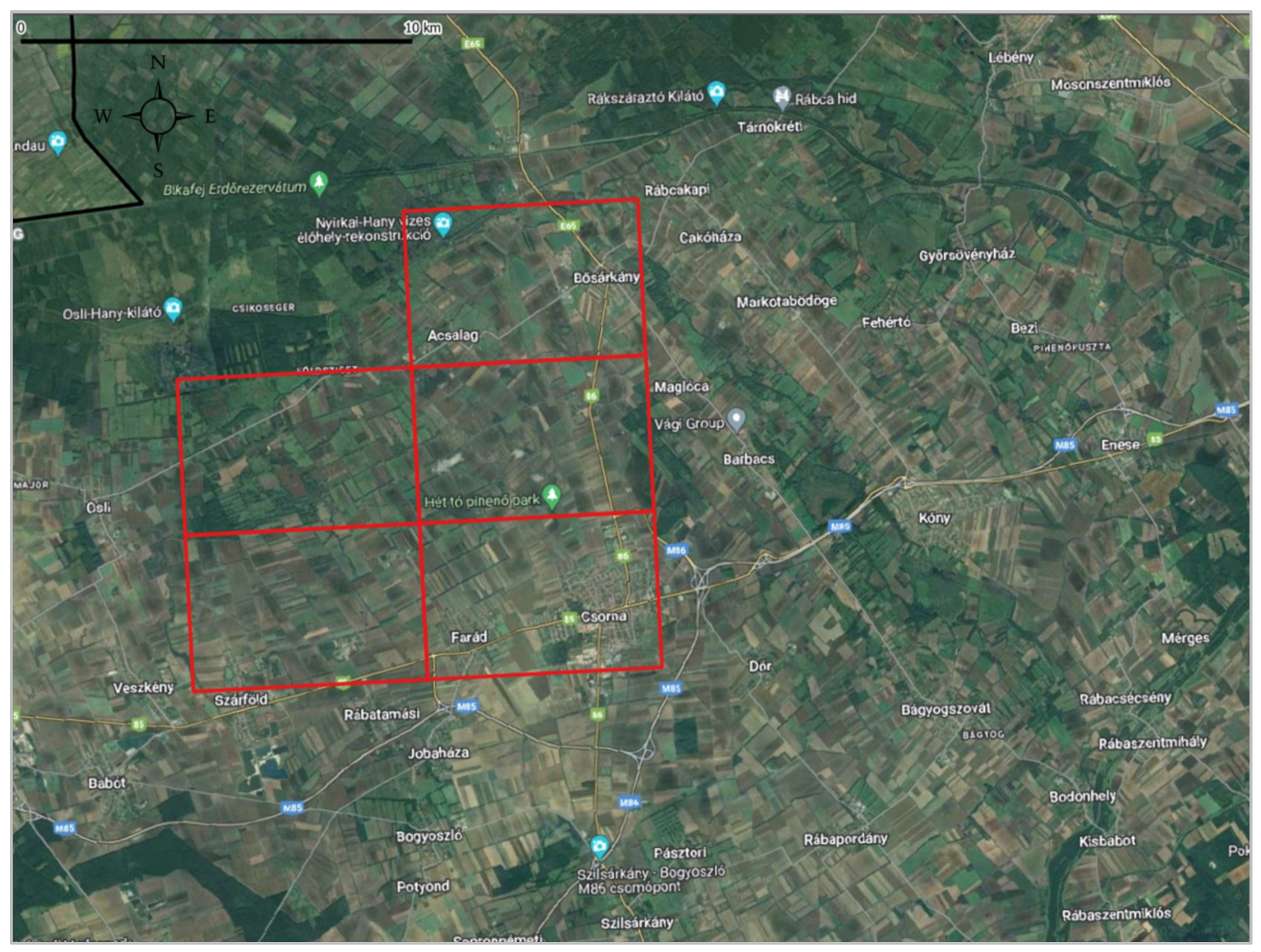
References
- Verkerk, P.J.; Delacote, P.; Hurmekoski, E.; Kunttu, J.; Matthews, R.; Mäkipää, R.; Mosley, F.; Perugini, L.; Reyer, C.P.; Roe, S.; et al. Forest-Based Climate Change Mitigation and Adaptation in Europe. From Science to Policy 14; European Forest Institute: Joensuu, Finland, 2022; ISBN 978-952-7426-22-7. [Google Scholar][Green Version]
- IPCC. Chapter 7 Agriculture, Forestry, and Other Land Uses (AFOLU). In Sixth Assessment Report, Climate Change 2022: Mitigation of Climate Change, the Working Group III Contribution; IPCC: Geneva, Switzerland, 2022. [Google Scholar][Green Version]
- Golicz, K.; Bellingrath-Kimura, S.; Breuer, L.; Wartenberg, A.C. Carbon accounting in European agroforestry systems—Key research gaps and data needs. Curr. Res. Environ. Sustain. 2022, 4, 100134. [Google Scholar] [CrossRef]
- Zomer, R.J.; Neufeldt, H.; Xu, J.; Ahrends, A.; Bossio, D.; Trabucco, A.; Van Noordwijk, M.; Wang, M. Global tree cover and biomass carbon on agricultural land: The contribution of agroforestry to global and national carbon budgets. Sci. Rep. 2016, 6, 29987. [Google Scholar] [CrossRef]
- Cardinael, R.; Cadisch, G.; Gosme, M.; Oelbermann, M.; van Noordwijk, M. Climate change mitigation and adaptation in agriculture: Why agroforestry should be part of the solution. Agric. Ecosyst. Environ. 2021, 319, 107555. [Google Scholar] [CrossRef]
- Torralba, M.; Fagerholm, N.; Burgess, P.J.; Moreno, G.; Plieninger, T. Do European agroforestry systems enhance bio-diversity and ecosystem services? A meta-analysis. Agric. Ecosyst. Environ. 2016, 230, 150–161. [Google Scholar] [CrossRef]
- Nair, P.K.R.; Nair, V.D.; Mohan Kumar, B.; Showalter, J.M. Carbon sequestration in agroforestry systems. In Sparks, Advances in Agronomy; Donald, L., Ed.; Academic Press: Cambridge, MA, USA, 2010; Volume 108, pp. 237–307. ISBN 9780123810311. [Google Scholar] [CrossRef]
- Mbow, C.; Smith, P.; Skole, D.; Duguma, L.; Bustamante, M. Achieving Mitigation and Adaptation to Climate Change through Sustainable Agroforestry Practices in Africa. Curr. Opin. Environ. Sustain. 2014, 6, 8–14. [Google Scholar] [CrossRef]
- Ellison, D.; Morris, C.E.; Locatelli, B.; Sheil, D.; Cohen, J.; Murdiyarso, D.; Gutierrez, V.; van Noordwijk, M.; Creed, I.F.; Pokorny, J.; et al. Trees, forests and water: Cool insights for a hot world. Glob. Environ. Chang. 2017, 37, 51–61. [Google Scholar] [CrossRef]
- Kuyah, S.; Whitney, C.W.; Jonsson, M.; Sileshi, G.W.; Öborn, I.; Muthuri, C.W.; Luedeling, E. Agroforestry delivers a win-win solution for ecosystem services in sub-Saharan Africa. A meta-analysis. Agron. Sustain. Dev. 2019, 39, 47. [Google Scholar] [CrossRef]
- Zhu, X.; Liu, W.; Chen, J.; Bruijnzeel, L.A.; Mao, Z.; Yang, X.; Cardinael, R.; Meng, F.-R.; Sidle, R.C.; Seitz, S.; et al. Reductions in water, soil and nutrient losses and pesticide pollution in agroforestry practices: A review of evidence and processes. Plant Soil 2020, 453, 45–86. [Google Scholar] [CrossRef]
- Muchane, M.N.; Sileshi, G.W.; Gripenberg, S.; Jonsson, M.; Pumariño, L.; Barrios, E. Agroforestry boosts soil health in the humid and sub-humid tropics: A meta-analysis. Agric. Ecosyst. Environ. 2020, 295, 106899. [Google Scholar] [CrossRef]
- Arenas-Corraliza, M.G.; López-Díaz, M.L.; Moreno, G. Winter cereal production in a Mediterranean silvoarable walnut system in the face of climate change. Agric. Ecosyst. Environ. 2018, 264, 111–118. [Google Scholar] [CrossRef]
- Sida, T.S.; Baudron, F.; Kim, H.; Giller, K.E. Climate-smart agroforestry: Faidherbia albida trees buffer wheat against climatic extremes in the Central Rift Valley of Ethiopia. Agric. For. Meteorol. 2018. [Google Scholar] [CrossRef]
- Ilstedt, U.; Bargués Tobella, A.; Bazié, H.R.; Bayala, J.; Verbeeten, E.; Nyberg, G.; Sanou, J.; Benegas, L.; Murdiyarso, D.; Laudon, H.; et al. Intermediate tree cover can maximize groundwater recharge in the seasonally 2 dry tropics. Sci. Rep. 2016, 6, 21930. [Google Scholar] [CrossRef] [PubMed]
- Bargués-Tobella, A.; Hasselquist, N.J.; Bazié, H.R.; Bayala, J.; Laudon, H.; Ilstedt, U. Trees in African drylands can promote deep soil and groundwater recharge in a future climate with more intense rainfall. Land Degrad. Dev. 2020, 34, 81–95. [Google Scholar] [CrossRef]
- Rosenstock, T.S.; Dawson, I.K.; Aynekulu, E.; Sola, P.; Shepherd, K.; Steward, P.; Jamnadass, R.; Kimaro, A.; Kindt, R.; Lamanna, C.; et al. A Planetary Health Perspective on Agroforestry in Sub-Saharan Africa. One Earth 2019, 1, 330–344. [Google Scholar] [CrossRef]
- McMullin, S.; Njogu, K.; Wekesa, B.; Gachuiri, A.; Ngethe, E.; Stadlmayr, B.; Jamnadass, R.; Kehlenbeck, K. Developing fruit tree portfolios that link agriculture more effectively with nutrition and health: A new ap-proach for providing year-round micronutrients to smallholder farmers. Food Secur. 2019, 11, 1355–1372. [Google Scholar] [CrossRef]
- Burgess, P.J.; Rosati, A. Advances in European agroforestry: Results from the AGFORWARD project. Agrofor. Syst. 2018, 92, 801–810. [Google Scholar] [CrossRef]
- Chapman, M.; Walker, W.S.; Cook-Patton, S.C.; Ellis, P.W.; Farina, M.; Griscom, B.W.; Baccini, A. Large climate mitigation potential from adding trees to agricultural lands. Glob. Chang. Biol. 2020, 26, 4357–4365. [Google Scholar] [CrossRef] [PubMed]
- Griscom, B.W.; Busch, J.; Cook-Patton, S.C.; Ellis, P.W.; Funk, J.; Leavitt, S.M.; Lomax, G.; Turner, W.R.; Chapman, M.; Engelmann, J.; et al. National mitigation potential from natural climate solutions in the tropics. Phil. Trans. R. Soc. 2020, B375, 20190126. [Google Scholar] [CrossRef]
- Joffre, R.; Vacher, J.; de los Llanos, C.; Long, G. The dehesa: An agrosilvopastoral system of 4 the Mediterranean region with special reference to the Sierra Morena area of Spain. Agrofor. Syst. 1988, 5, 25. [Google Scholar] [CrossRef]
- Rigueiro-Rodriguez, A.; McAdam, J.; Mosquera-Losada, M.R. Agroforestry in Europe—Current Status and Future Prospects; Springer: Dordrecht, The Netherlands, 2009. [Google Scholar]
- Kay, S.; Rega, C.; Moreno, G.; den Herder, M.; Palma, J.H.N.; Borek, R.; Crous-Duran, J.; Freese, D.; Giannitsopoulos, M.; Graves, A.; et al. Agroforestry Creates Carbon Sinks Whilst Enhancing the Environment in Agricultural Landscapes in Europe. Land Use Policy 2019, 83, 581–593. [Google Scholar] [CrossRef]
- De Stefano, A.; Jacobson, M.G. Soil carbon sequestration in agroforestry systems: A meta-25 analysis. Agrofor. Syst. 2018, 92, 285–299. [Google Scholar] [CrossRef]
- Cardinael, R.; Umulisa, V.; Toudert, A.; Olivier, A.; Bockel, L.; Bernoux, M. Revisiting IPCC Tier 1 coefficients for soil organic and biomass carbon storage in agroforestry systems. Environ. Res. Lett. 2018, 13, 124020. [Google Scholar] [CrossRef]
- IPCC. Refinement to the 2006 IPCC Guidelines for National Greenhouse Gas Inventories; Calvo Buendia, E., Tanabe, K., Kranjc, A., Baasansuren, J., Fukuda, M., Ngarize, S., Osako, A., Pyrozhenko, Y., Shermanau, P., Federici, S., Eds.; IPCC: Geneva, Switzerland, 2019. [Google Scholar]
- Nair, P.K.R. An Introduction to Agroforestry; Klgwer Academic Publishers: Dordrecht, The Netherlands, 1971; p. 489. ISBN 0-7923-2134-0. [Google Scholar]
- Honfy, V.; Pödör, Z.; Keserű, Z.; Rásó, J.; Ábri, T.; Borovics, A. The Effect of Tree Spacing on Yields of Alley Cropping Systems—A Case Study from Hungary. Plants 2023, 12, 595. [Google Scholar] [CrossRef] [PubMed]
- Mayer, S.; Wiesmeier, M.; Sakamoto, E.; Hübner, R.; Cardinael, R.; Kühnel, A.; Kögel-Knabner, I. Soil organic carbon sequestration in temperate agroforestry systems—A meta-analysis. Agric. Ecosyst. Environ 2022, 323, 107689. [Google Scholar] [CrossRef]
- Morhart, C.; Sheppard, J.P.; Schuler, J.K.; Spiecker, H. Above-ground woody biomass allocation and within tree carbon and nutrient distribution of wild cherry (Prunus avium L.)—A case study. For. Ecosyst. 2016, 3, 4. [Google Scholar] [CrossRef]
- Eighth National Communication and Fifth Biennial Report of Hungary. 4 August 2023, p. 291. Available online: https://unfccc.int/documents/630941 (accessed on 12 December 2023).
- NIR. Chapter: Land-Use, Land-Use Change and Forestry. In National Inventory Report for 1985–2021; Somogyi, Z., Tobisch, T., Király, É., Eds.; Hungarian Meteorological Service: Budapest, Hungary, 2023. [Google Scholar]
- EU/2018/841: REGULATION (EU) 2018/841 OF THE EUROPEAN PARLIAMENT AND OF THE COUNCIL of 30 May 2018 on the Inclusion of Greenhouse Gas Emissions and Removals from Land use, Land Use Change and Forestry in the 2030 Climate and Energy Framework, and Amending Regulation (EU) No 525/2013 and Decision No 529/2013/EU. Available online: https://eur-lex.europa.eu/legal-content/EN/TXT/?uri=CELEX%3A32018R0841 (accessed on 12 December 2023).
- COM/2020/381: Communication from the Commission to the European Parliament, the Council, the European Economic and Social Committee and the Committee of the Regions. A Farm to Fork Strategy for a Fair, Healthy and Environmentally-Friendly Food System. Available online: https://eur-lex.europa.eu/legal-content/EN/TXT/?uri=CELEX:52020DC0381 (accessed on 12 December 2023).
- NAK. Fától az Erdőig—új Támogatási Lehetőségek. National Chamber of Agriculture. 2022. Available online: https://www.nak.hu/tajekoztatasi-szolgaltatas/erdogazdalkodas/104858-fatol-az-erdoig-uj-tamogatasi-lehetosegek (accessed on 12 December 2023).
- Tobisch, T.; Kottek, P. Forestry-Related Databases of the Hungarian Forestry Directorate, Version 1.1; NFCSO: Budapest, Hungary, 2013. [Google Scholar]
- Kottek, P.; Király, É.; Mertl, T.; Borovics, A. The Re-parametrization of the DAS Model Based on 2016–2021 Data of the National Forestry Database: New Results on Cutting Age Distributions. Acta Silv. Lignaria Hung. 2023, 19, 61–74. [Google Scholar] [CrossRef]
- Erdőtérkép. 2023. Available online: https://erdoterkep.nebih.gov.hu/ (accessed on 12 December 2023).
- Zentai, L.; Gercsák, G. Cross-border topographic mapping, cross-border orienteering: The Hungarian overview. Intl. J. Cartogr. 2019, 5, 255–268. [Google Scholar] [CrossRef]
- IPCC. IPCC Guidelines for National Greenhouse Gas Inventories, Prepared by the National Greenhouse Gas Inventories Programme; Eggleston, H.S., Buendia, L., Miwa, K., Ngara, T., Tanabe, K., Eds.; IGES: Kanagawa, Japan, 2006. [Google Scholar]
- Somogyi, Z. A hazai erdők üvegház hatású gáz leltára. Erdészeti kutatások 2007–2008. 2008; Volume 92; p. 154. Available online: http://www.erti.hu/ek.php?id=1&fn=vol92 (accessed on 12 December 2023).
- Dövényi, Z. Magyarország Kistájainak Katasztere 1. [Inventory of Microregions in Hungary]; MTA Földrajztudományi Kutatóintézet: Budapest, Hungary, 2010; p. 430. [Google Scholar]
- HUN CRF. National inventory Submission of Hungary—Common Reporting Tables 2023. Available online: https://unfccc.int/documents/627846 (accessed on 12 December 2023).
- Amichev, B.Y.; Bentham, M.J.; Kurz, W.A.; Laroque, C.P.; Kulshreshtha, S.; Piwowar, J.M.; Van Rees, K.C.J. Carbon Sequestration by White Spruce Shelterbelts in Saskatchewan, Canada: 3PG and CBM-CFS3 Model Simulations. Ecol. Model. 2016, 325, 35–46. [Google Scholar] [CrossRef]
- Oelbermann, M.; Voroney, R.P.; Gordon, A.M. Carbon Sequestration in Tropical and Temperate Agroforestry Systems: A Review with Examples from Costa Rica and Southern Canada. Agric. Ecosyst. Environ. 2004, 104, 359–377. [Google Scholar] [CrossRef]
- Dhillon, G.S.; Van Rees, K.C. Soil organic carbon sequestration by shelterbelt agroforestry systems in Saskatchewan. Can. J. Soil Sci. 2017, 97, 394–409. [Google Scholar] [CrossRef]
- Drexler, S.; Gensior, A.; Don, A. Carbon sequestration in hedgerow biomass and soil in the temperate climate zone. Reg. Environ. Chang. 2021, 21, 74. [Google Scholar] [CrossRef]
- Ma, Z.; Bork, E.W.; Carlyle, C.N.; Tieu, J.; Gross, C.D.; Chang, S.X. Carbon stocks differ among land-uses in agroforestry systems in western Canada. Agric. For. Meteorol. 2022, 313, 108756. [Google Scholar] [CrossRef]
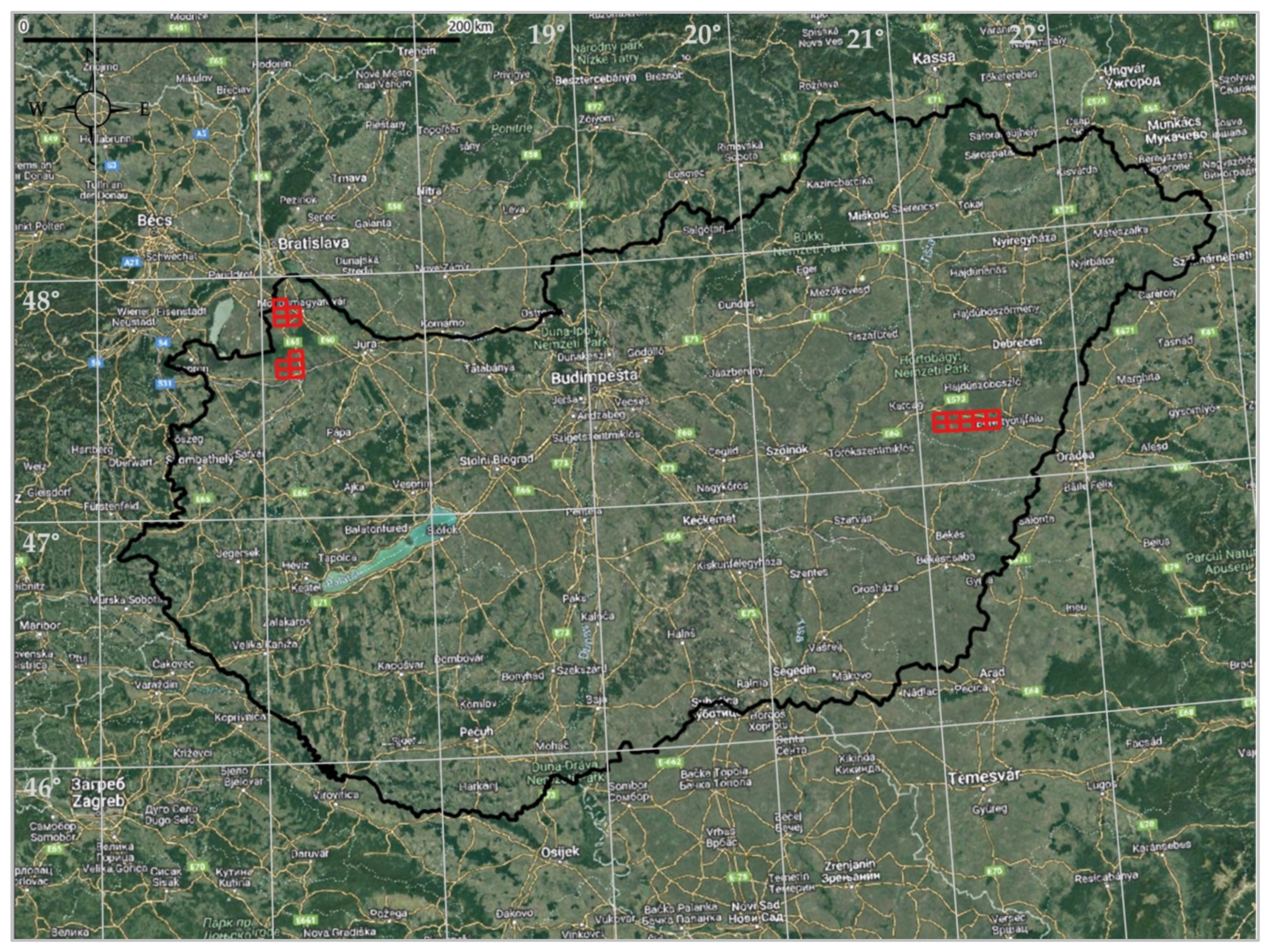
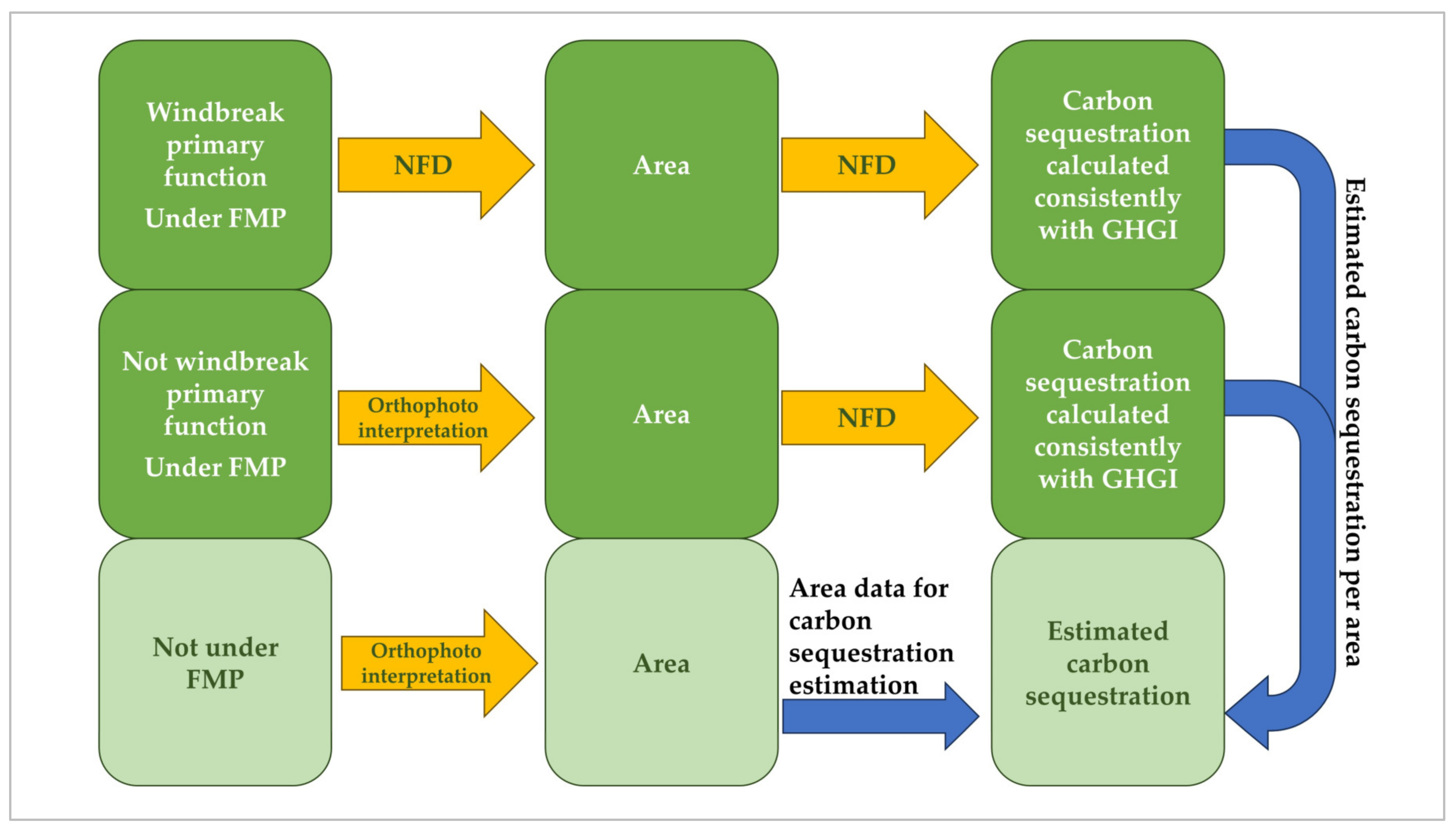
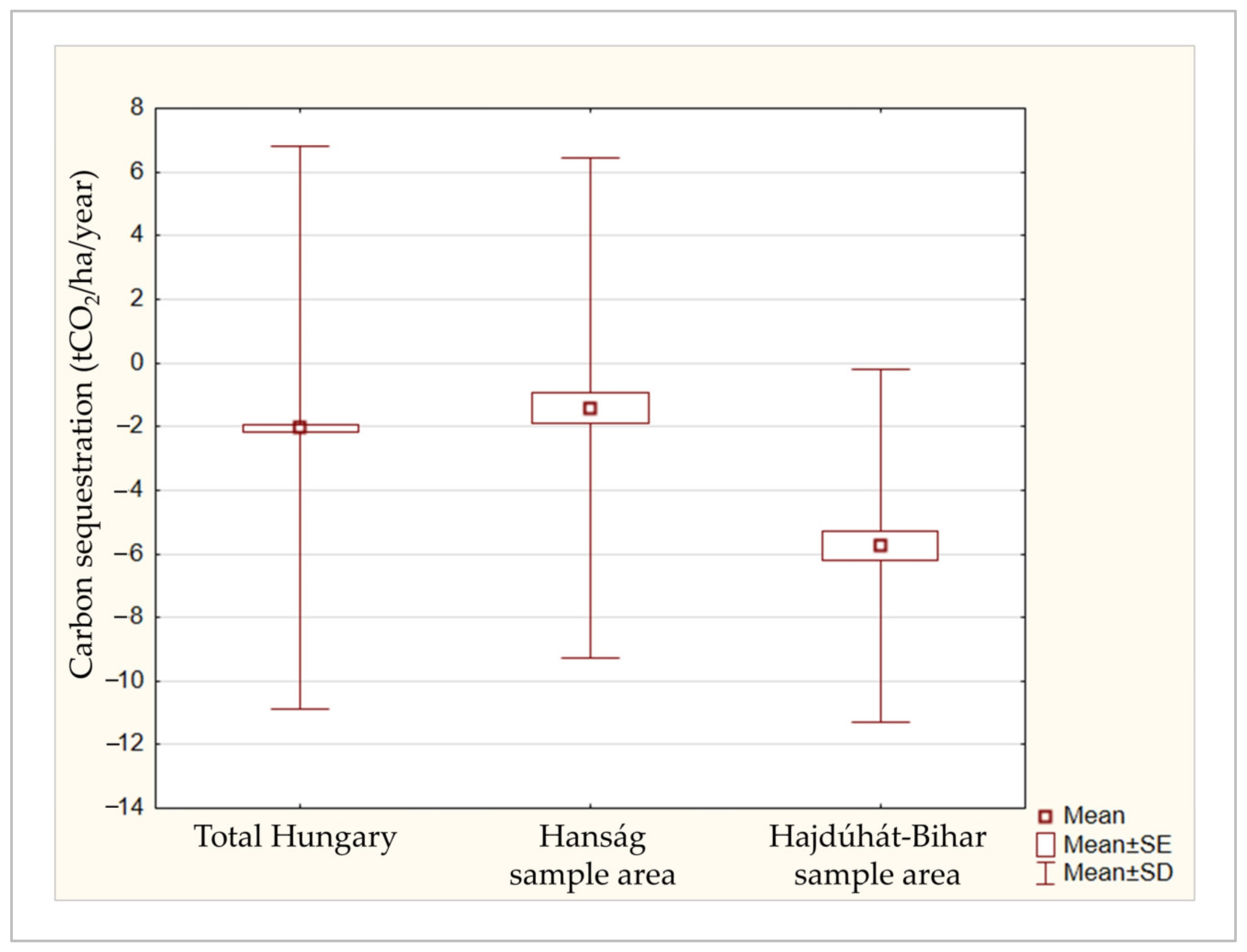
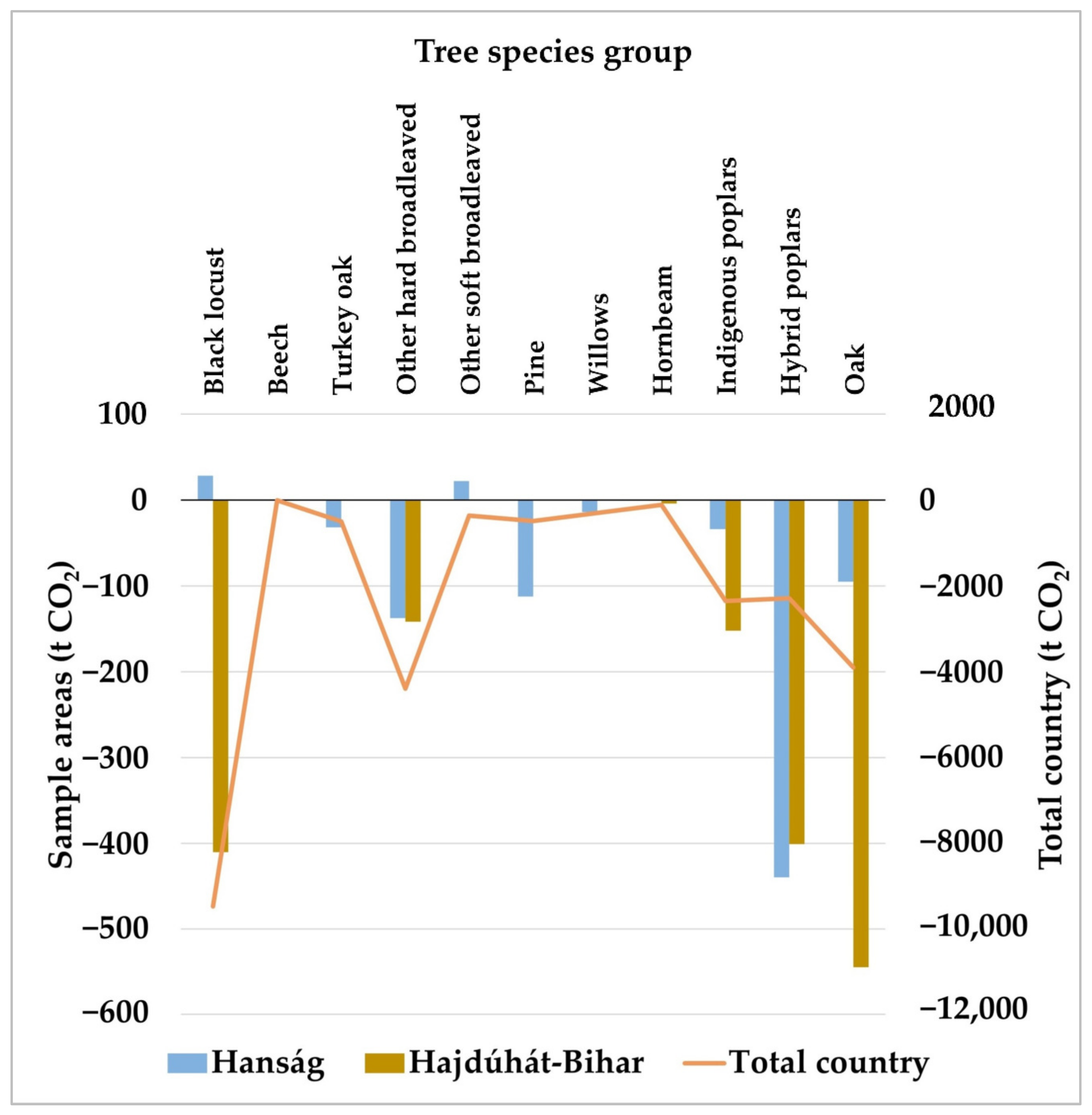
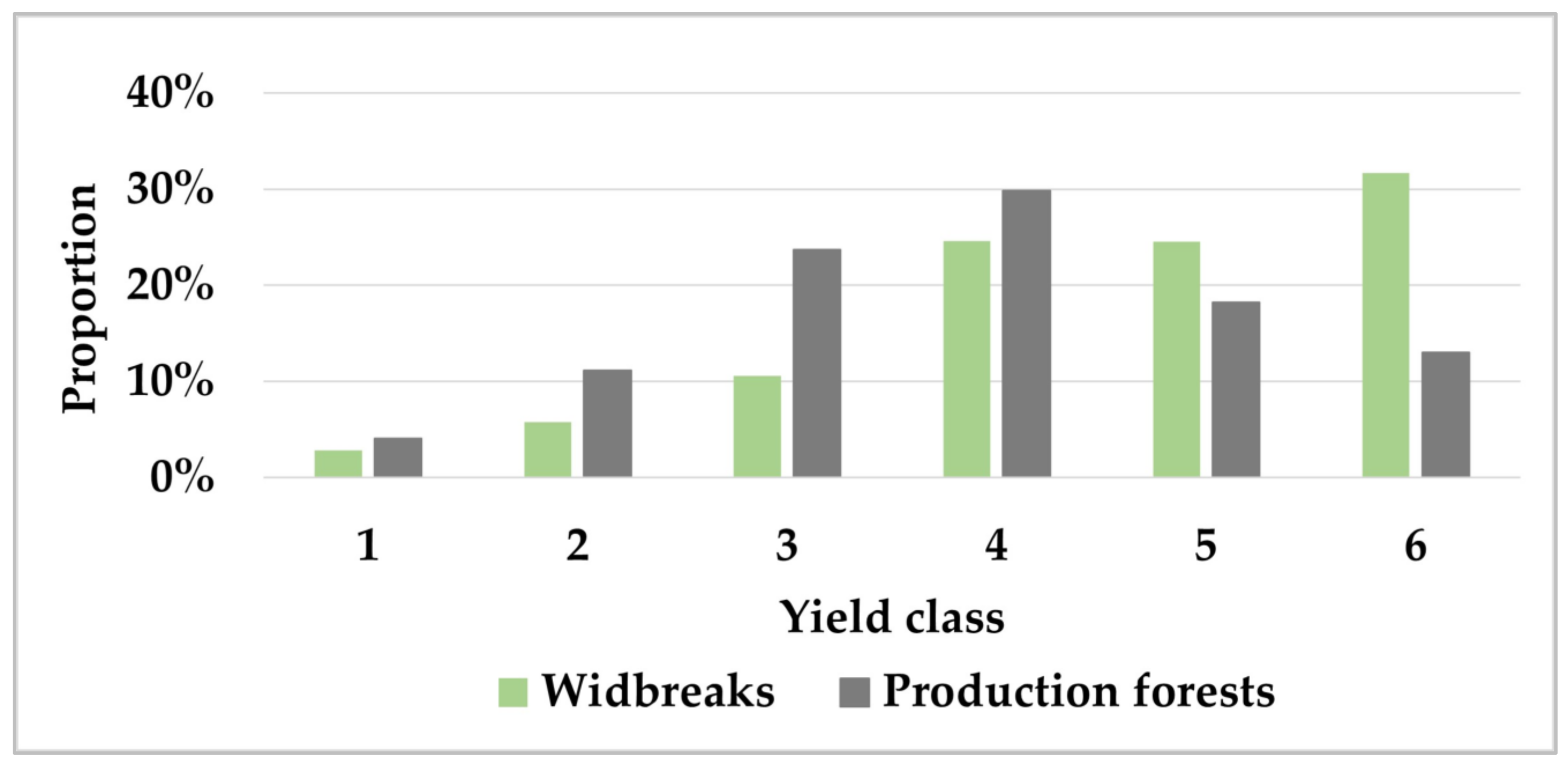
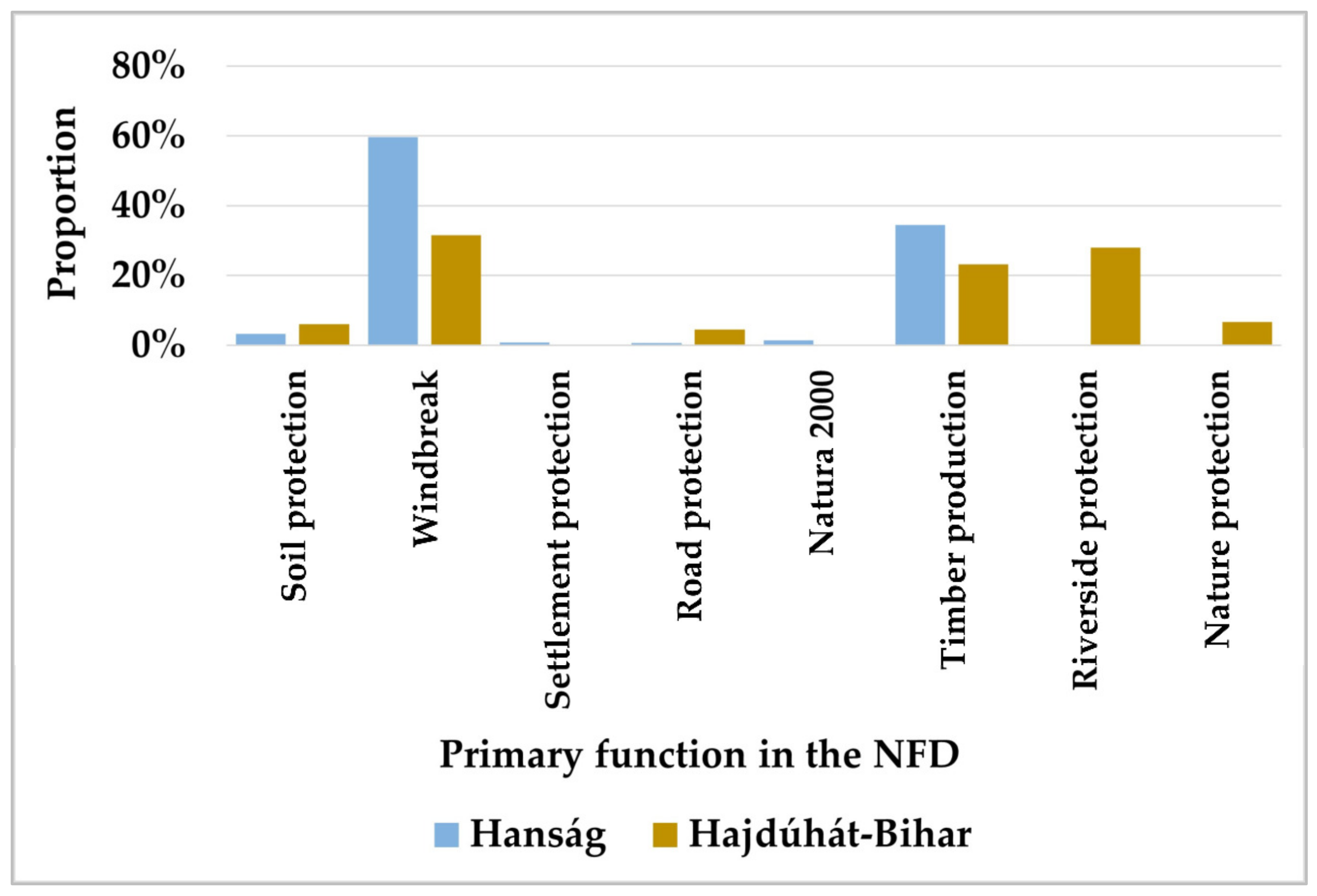

| Hanság Sample Area | Hajdúhát-Bihar Sample Area | Total for Hungary | |
|---|---|---|---|
| Windbreaks under FMP with windbreak as the primary function | NFD data on the area and wood stock change between 2010 and 2020 (queried from the NFD based on primary function identifier code); carbon sequestration calculated based on IPCC methodology. | NFD data on the area and wood stock change between 2010 and 2020 (queried from the NFD based on primary function identifier code); carbon sequestration calculated based on IPCC methodology. | NFD data on the area and wood stock change between 2010 and 2020 (queried from the NFD based on primary function identifier code); carbon sequestration calculated based on IPCC methodology. |
| Windbreaks under FMP without windbreak as the primary function | Identified using orthophoto interpretation; NFD data on the area and wood stock change between 2010 and 2020 (queried from the NFD based on sub-compartment identifier code). | Identified using orthophoto interpretation; NFD data on the area and wood stock change between 2010 and 2020 (queried from the NFD based on sub-compartment identifier code). | Unidentified, NE |
| Windbreaks not under FMP | Area data obtained using orthophoto interpretation | Area data obtained using orthophoto interpretation | Estimated area and carbon sequestration |
| Hanság—Windbreaks under FMP | Hanság—Windbreaks Not under FMP | Hajdúhát-Bihar —Windbreaks under FMP | Hajdúhát-Bihar— Windbreaks Not under FMP | Total Hungary— Windbreaks under FMP | Total Hungary —Windbreaks Not under FMP | Total Hungary —All Windbreaks | |
|---|---|---|---|---|---|---|---|
| Total area (ha) | 472 | 389 | 258 | 184 | 10,089 | 4237 (est.) | 14,300 (est.) |
| Area not subject to final harvest in the study period (ha) | 438 | NE | 254 | NE | 8883 | NE | NE |
| Final harvest % | 7% | NE | 1% | NE | 12% | NE | NE |
| Total carbon sequestration (t CO2) | −811 | −554 | −1652 | −1058 | −24,135 | −8944 | −33,079 |
| Mean carbon sequestration in the aboveground biomass (t CO2/ha/year) | −1.4 | −1.4 (est.) | −5.8 | −5.8 (est.) | −2.0 | −2.0 (est.) | −2.0 (est.) |
| Mean carbon sequestration in the aboveground biomass weighted with the area (t CO2/ha/year) | −1.7 | NE | −6.4 | NE | −2.4 | NE | NE |
| Mean carbon sequestration in the aboveground biomass of the areas not subject to final harvest in the study period (t CO2/ha/year) | −2.5 | NE | −6.3 | NE | −3.5 | NE | NE |
| Mean carbon sequestration in the aboveground biomass of the areas not subject to final harvest in the study period weighted with the area (t CO2/ha/year) | −2.6 | NE | −6.8 | NE | −3.9 | NE | NE |
Disclaimer/Publisher’s Note: The statements, opinions and data contained in all publications are solely those of the individual author(s) and contributor(s) and not of MDPI and/or the editor(s). MDPI and/or the editor(s) disclaim responsibility for any injury to people or property resulting from any ideas, methods, instructions or products referred to in the content. |
© 2023 by the authors. Licensee MDPI, Basel, Switzerland. This article is an open access article distributed under the terms and conditions of the Creative Commons Attribution (CC BY) license (https://creativecommons.org/licenses/by/4.0/).
Share and Cite
Király, É.; Keserű, Z.; Molnár, T.; Szabó, O.; Borovics, A. Carbon Sequestration in the Aboveground Living Biomass of Windbreaks—Climate Change Mitigation by Means of Agroforestry in Hungary. Forests 2024, 15, 63. https://doi.org/10.3390/f15010063
Király É, Keserű Z, Molnár T, Szabó O, Borovics A. Carbon Sequestration in the Aboveground Living Biomass of Windbreaks—Climate Change Mitigation by Means of Agroforestry in Hungary. Forests. 2024; 15(1):63. https://doi.org/10.3390/f15010063
Chicago/Turabian StyleKirály, Éva, Zsolt Keserű, Tamás Molnár, Orsolya Szabó, and Attila Borovics. 2024. "Carbon Sequestration in the Aboveground Living Biomass of Windbreaks—Climate Change Mitigation by Means of Agroforestry in Hungary" Forests 15, no. 1: 63. https://doi.org/10.3390/f15010063
APA StyleKirály, É., Keserű, Z., Molnár, T., Szabó, O., & Borovics, A. (2024). Carbon Sequestration in the Aboveground Living Biomass of Windbreaks—Climate Change Mitigation by Means of Agroforestry in Hungary. Forests, 15(1), 63. https://doi.org/10.3390/f15010063







